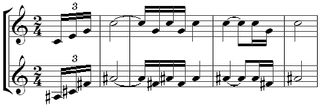
Polytonality is the musical use of more than one key simultaneously. Bitonality is the use of only two different keys at the same time. Polyvalence is the use of more than one harmonic function, from the same key, at the same time.
An octatonic scale is any eight-note musical scale. However, the term most often refers to the symmetric scale composed of alternating whole and half steps, as shown at right. In classical theory, this scale is commonly simply called the octatonic scale although there are a total of 42 non-enharmonically equivalent, non-transpositionally equivalent eight-note sets.

The String Quartet No. 5, Sz. 102, BB 110 by Béla Bartók was written between 6 August and 6 September 1934. It is one of six string quartets by Bartok.
In music, arch form is a sectional structure for a piece of music based on repetition, in reverse order, of all or most musical sections such that the overall form is symmetric, most often around a central movement. The sections need not be repeated verbatim but must at least share thematic material.
Chester Simon Kallman was an American poet, librettist, and translator, best known for collaborating with W. H. Auden on opera librettos for Igor Stravinsky and other composers.
Béla Bartók's Piano Concerto No. 3 in E major, Sz. 119, BB 127 is a musical composition for piano and orchestra. Bartók composed the piece in 1945 during the final months of his life, as a surprise birthday present for his second wife Ditta Pásztory-Bartók. It consists of three movements.

The Viola Concerto, Sz. 120, BB 128 was one of the last pieces written by Béla Bartók. He began composing his viola concerto while living in Saranac Lake, New York, in July 1945. The piece was commissioned by William Primrose, a respected violist who knew that Bartók could provide a challenging piece for him to perform. He said that Bartók should not "feel in any way proscribed by the apparent technical limitations of the instrument"; Bartók, though, was suffering from the terminal stages of leukemia when he began writing the viola concerto and left only sketches at the time of his death.
In music, polymodal chromaticism is the use of any and all musical modes sharing the same tonic simultaneously or in succession and thus creating a texture involving all twelve notes of the chromatic scale. Alternately it is the free alteration of the other notes in a mode once its tonic has been established.

In music a distance model is the alternation of two different intervals to create a non-diatonic musical mode such as the 1:3 distance model, the alternation of semitones and minor thirds: C-E♭-E-G-A♭-B-C. This scale is also an example of polymodal chromaticism as it includes both the tonic and dominant as well as "'two of the most typical degrees from both major and minor' ".
In music a privileged pattern is a motive, figure, or chord which is repeated and transposed so that the transpositions form a recognizable pattern. The pattern of transposition may be either by a repeated interval, an interval cycle, or a stepwise line of whole tones and semitones. The pattern is said to be privileged because it requires no context and is a precompositional technique.
In music, the acoustic scale, overtone scale, Lydian dominant scale, or Lydian ♭7 scale, is a seven-note synthetic scale.
In music, the axis system is a system of analysis originating in the work of Ernő Lendvai, which he developed in his analysis of the music of Béla Bartók.
Paul Wilson is a music theorist and Professor of Music Theory and Composition at the University of Miami Frost School of Music, in the United States. He holds a B.A. from Harvard University, a M.A. from the University of Hawaii, and M.Phil. and Ph.D. degrees from Yale University, where he studied with Allen Forte.
Bimodality is the simultaneous use of two distinct pitch collections. It is more general than bitonality since the "scales" involved need not be traditional scales; if diatonic collections are involved, their pitch centers need not be the familiar major and minor-scale tonics. One example is the opening of Béla Bartók's "Boating" from Mikrokosmos. Here, the right hand uses pitches of the pentatonic scale on E♭ and the left hand uses those of the diatonic hexachord on C, perhaps suggesting G dorian or G mixolydian.
A clarinet-violin-piano trio is a standardized chamber musical ensemble made up of one clarinet, one violin, and one piano participating in relatively equal roles, or the name of a piece written for such a group.
In music composition, fragmentation is the use of fragments or the "division of a musical idea into segments". It is used in tonal and atonal music, and is a common method of localized development and closure.
Out of Doors is a set of five piano solo pieces, Sz.. 81, BB 89, written by Béla Bartók in 1926. Out of Doors is among the very few instrumental compositions by Bartók with programmatic titles.





